Literature Review: Potential Measures for Reducing Ship Emissions
VerifiedAdded on 2020/07/22
|8
|2298
|60
Report
AI Summary
This literature review examines the significant impact of ship emissions on the marine environment, highlighting the role of technological advancements, business and commercial pressures, and resource issues, particularly the depletion of oil. The report explores the effects of carbon dioxide, SOx, and NOx emissions, emphasizing their contribution to global warming, air and water pollution. It discusses various potential solutions, including the development of green ships, the use of scrubber technology, and the implementation of low-sulfur fuel oils. The methodology involves a comprehensive search and analysis of relevant literature, with proper citations to ensure the authenticity of the information. The review concludes by emphasizing the urgent need for effective emission control measures to protect both the environment and human health. The research synthesizes information from various sources, including academic journals and books, to provide a comprehensive overview of the challenges and potential solutions in reducing ship emissions.
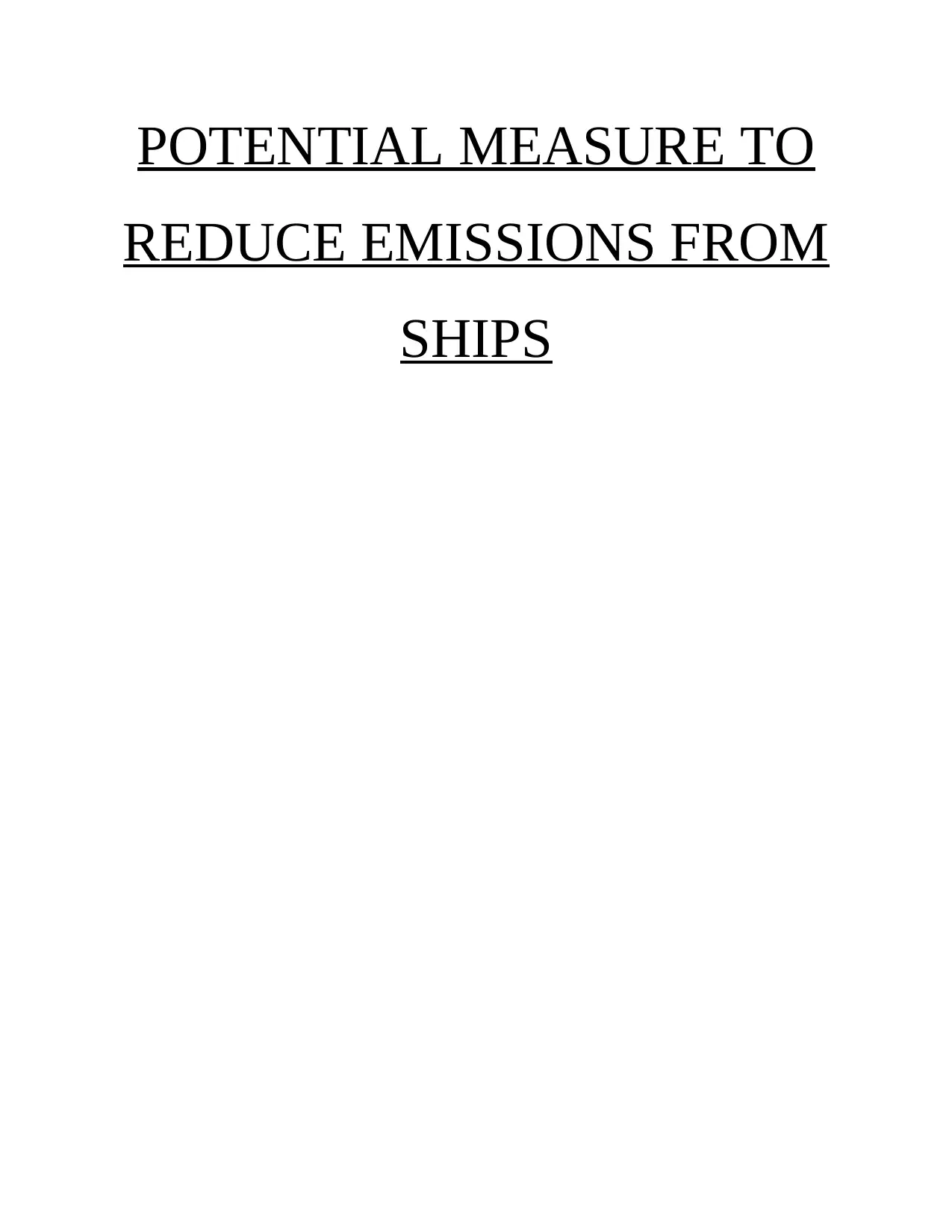
POTENTIAL MEASURE TO
REDUCE EMISSIONS FROM
SHIPS
REDUCE EMISSIONS FROM
SHIPS
Secure Best Marks with AI Grader
Need help grading? Try our AI Grader for instant feedback on your assignments.
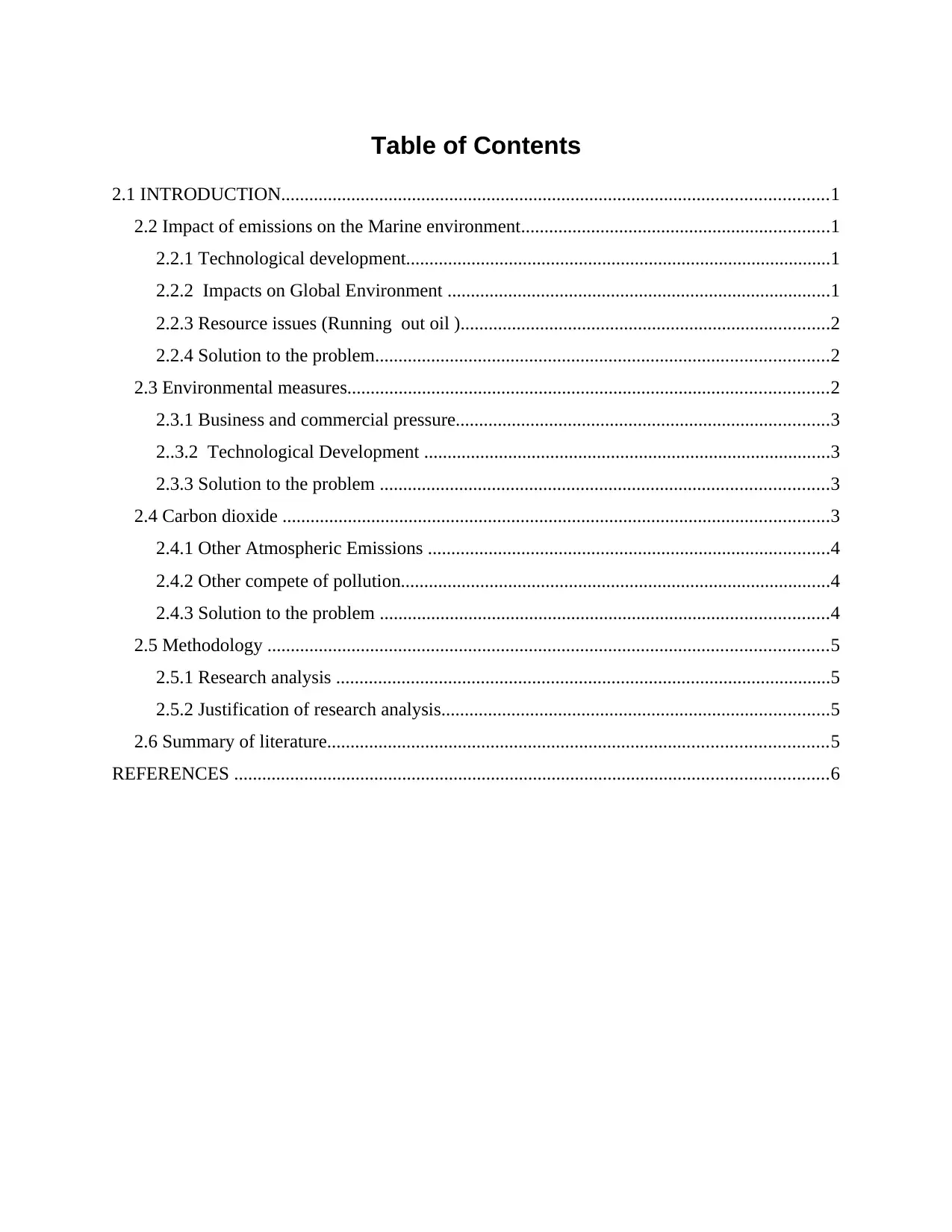
Table of Contents
2.1 INTRODUCTION.....................................................................................................................1
2.2 Impact of emissions on the Marine environment..................................................................1
2.2.1 Technological development...........................................................................................1
2.2.2 Impacts on Global Environment ..................................................................................1
2.2.3 Resource issues (Running out oil )...............................................................................2
2.2.4 Solution to the problem.................................................................................................2
2.3 Environmental measures.......................................................................................................2
2.3.1 Business and commercial pressure................................................................................3
2..3.2 Technological Development .......................................................................................3
2.3.3 Solution to the problem ................................................................................................3
2.4 Carbon dioxide .....................................................................................................................3
2.4.1 Other Atmospheric Emissions ......................................................................................4
2.4.2 Other compete of pollution............................................................................................4
2.4.3 Solution to the problem ................................................................................................4
2.5 Methodology ........................................................................................................................5
2.5.1 Research analysis ..........................................................................................................5
2.5.2 Justification of research analysis...................................................................................5
2.6 Summary of literature...........................................................................................................5
REFERENCES ...............................................................................................................................6
2.1 INTRODUCTION.....................................................................................................................1
2.2 Impact of emissions on the Marine environment..................................................................1
2.2.1 Technological development...........................................................................................1
2.2.2 Impacts on Global Environment ..................................................................................1
2.2.3 Resource issues (Running out oil )...............................................................................2
2.2.4 Solution to the problem.................................................................................................2
2.3 Environmental measures.......................................................................................................2
2.3.1 Business and commercial pressure................................................................................3
2..3.2 Technological Development .......................................................................................3
2.3.3 Solution to the problem ................................................................................................3
2.4 Carbon dioxide .....................................................................................................................3
2.4.1 Other Atmospheric Emissions ......................................................................................4
2.4.2 Other compete of pollution............................................................................................4
2.4.3 Solution to the problem ................................................................................................4
2.5 Methodology ........................................................................................................................5
2.5.1 Research analysis ..........................................................................................................5
2.5.2 Justification of research analysis...................................................................................5
2.6 Summary of literature...........................................................................................................5
REFERENCES ...............................................................................................................................6
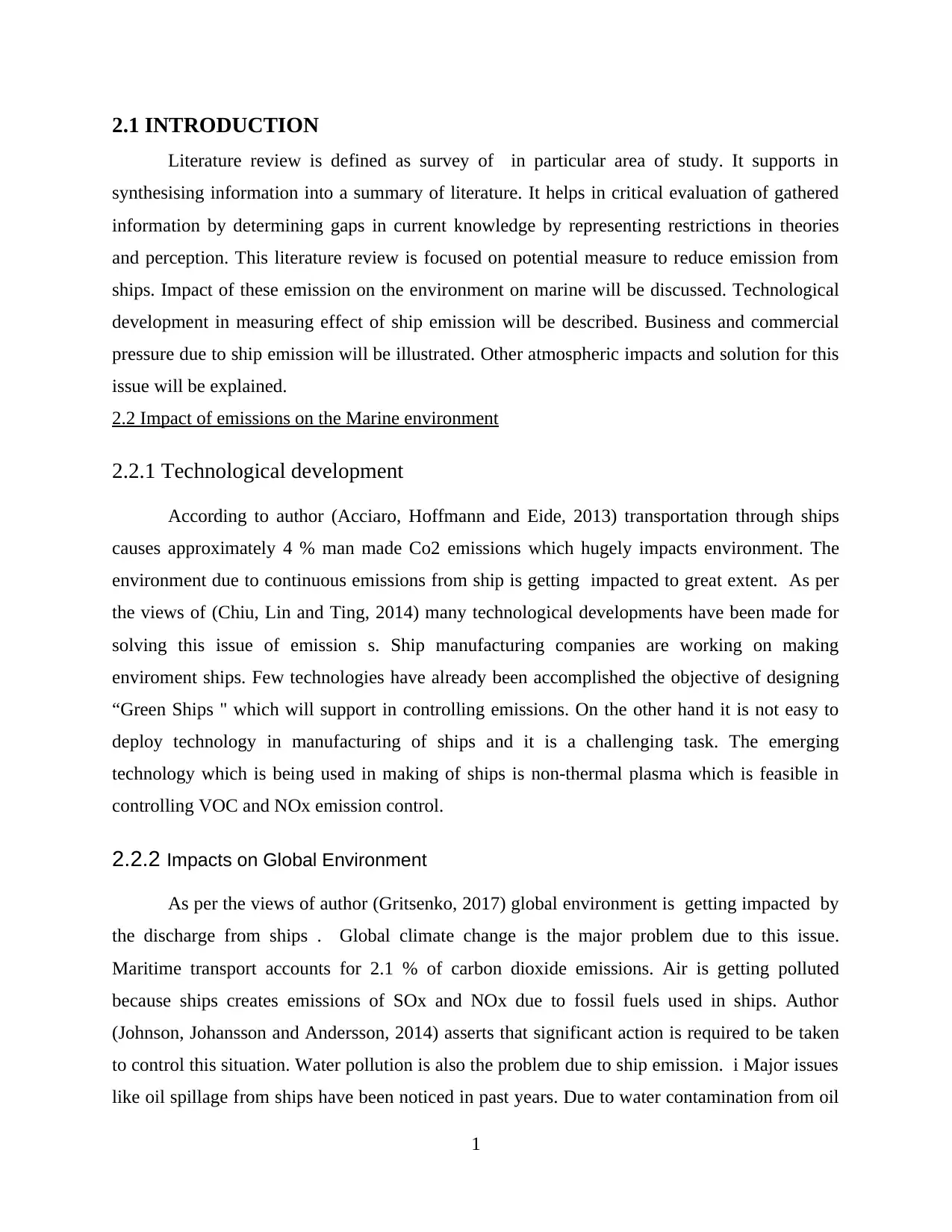
2.1 INTRODUCTION
Literature review is defined as survey of in particular area of study. It supports in
synthesising information into a summary of literature. It helps in critical evaluation of gathered
information by determining gaps in current knowledge by representing restrictions in theories
and perception. This literature review is focused on potential measure to reduce emission from
ships. Impact of these emission on the environment on marine will be discussed. Technological
development in measuring effect of ship emission will be described. Business and commercial
pressure due to ship emission will be illustrated. Other atmospheric impacts and solution for this
issue will be explained.
2.2 Impact of emissions on the Marine environment
2.2.1 Technological development
According to author (Acciaro, Hoffmann and Eide, 2013) transportation through ships
causes approximately 4 % man made Co2 emissions which hugely impacts environment. The
environment due to continuous emissions from ship is getting impacted to great extent. As per
the views of (Chiu, Lin and Ting, 2014) many technological developments have been made for
solving this issue of emission s. Ship manufacturing companies are working on making
enviroment ships. Few technologies have already been accomplished the objective of designing
“Green Ships " which will support in controlling emissions. On the other hand it is not easy to
deploy technology in manufacturing of ships and it is a challenging task. The emerging
technology which is being used in making of ships is non-thermal plasma which is feasible in
controlling VOC and NOx emission control.
2.2.2 Impacts on Global Environment
As per the views of author (Gritsenko, 2017) global environment is getting impacted by
the discharge from ships . Global climate change is the major problem due to this issue.
Maritime transport accounts for 2.1 % of carbon dioxide emissions. Air is getting polluted
because ships creates emissions of SOx and NOx due to fossil fuels used in ships. Author
(Johnson, Johansson and Andersson, 2014) asserts that significant action is required to be taken
to control this situation. Water pollution is also the problem due to ship emission. i Major issues
like oil spillage from ships have been noticed in past years. Due to water contamination from oil
1
Literature review is defined as survey of in particular area of study. It supports in
synthesising information into a summary of literature. It helps in critical evaluation of gathered
information by determining gaps in current knowledge by representing restrictions in theories
and perception. This literature review is focused on potential measure to reduce emission from
ships. Impact of these emission on the environment on marine will be discussed. Technological
development in measuring effect of ship emission will be described. Business and commercial
pressure due to ship emission will be illustrated. Other atmospheric impacts and solution for this
issue will be explained.
2.2 Impact of emissions on the Marine environment
2.2.1 Technological development
According to author (Acciaro, Hoffmann and Eide, 2013) transportation through ships
causes approximately 4 % man made Co2 emissions which hugely impacts environment. The
environment due to continuous emissions from ship is getting impacted to great extent. As per
the views of (Chiu, Lin and Ting, 2014) many technological developments have been made for
solving this issue of emission s. Ship manufacturing companies are working on making
enviroment ships. Few technologies have already been accomplished the objective of designing
“Green Ships " which will support in controlling emissions. On the other hand it is not easy to
deploy technology in manufacturing of ships and it is a challenging task. The emerging
technology which is being used in making of ships is non-thermal plasma which is feasible in
controlling VOC and NOx emission control.
2.2.2 Impacts on Global Environment
As per the views of author (Gritsenko, 2017) global environment is getting impacted by
the discharge from ships . Global climate change is the major problem due to this issue.
Maritime transport accounts for 2.1 % of carbon dioxide emissions. Air is getting polluted
because ships creates emissions of SOx and NOx due to fossil fuels used in ships. Author
(Johnson, Johansson and Andersson, 2014) asserts that significant action is required to be taken
to control this situation. Water pollution is also the problem due to ship emission. i Major issues
like oil spillage from ships have been noticed in past years. Due to water contamination from oil
1
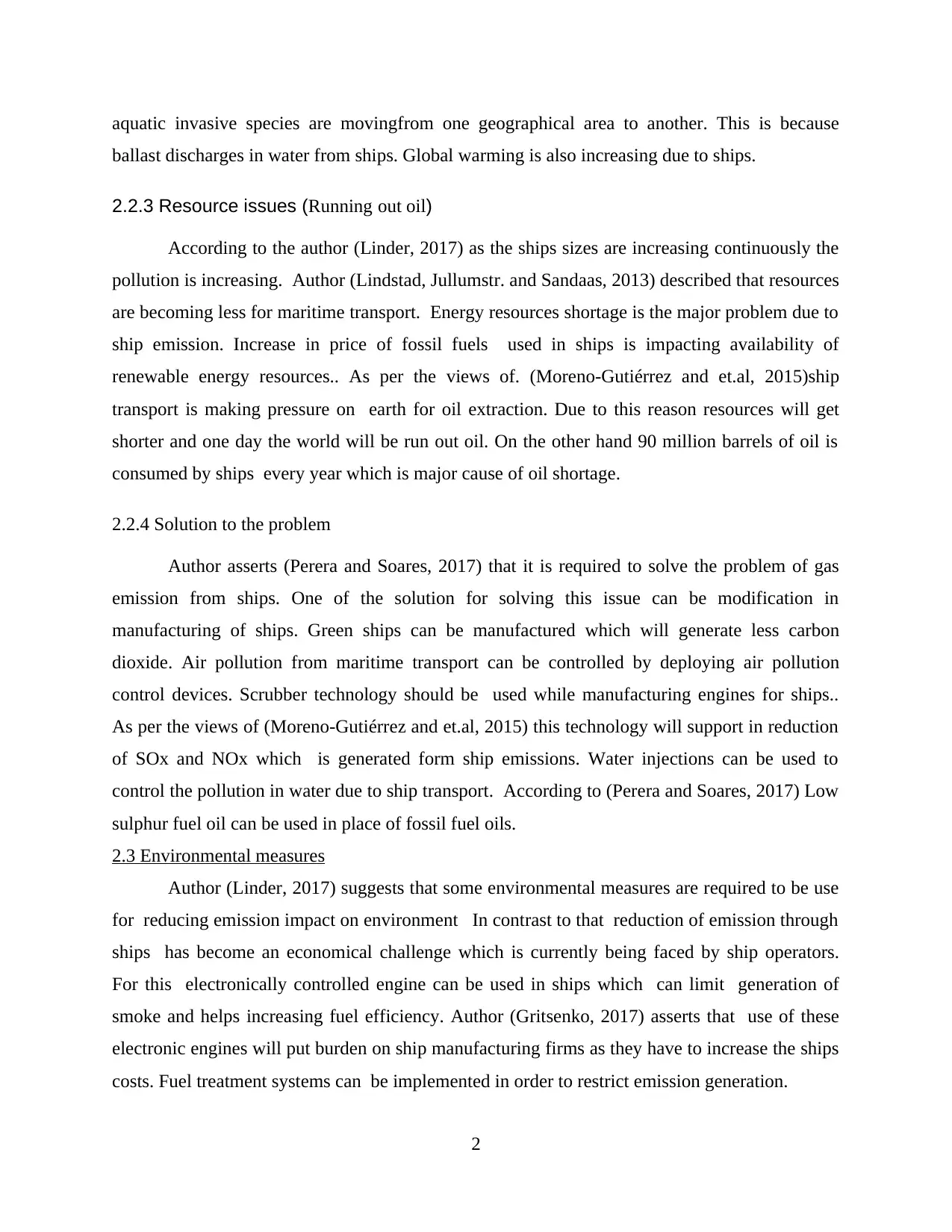
aquatic invasive species are movingfrom one geographical area to another. This is because
ballast discharges in water from ships. Global warming is also increasing due to ships.
2.2.3 Resource issues (Running out oil)
According to the author (Linder, 2017) as the ships sizes are increasing continuously the
pollution is increasing. Author (Lindstad, Jullumstr. and Sandaas, 2013) described that resources
are becoming less for maritime transport. Energy resources shortage is the major problem due to
ship emission. Increase in price of fossil fuels used in ships is impacting availability of
renewable energy resources.. As per the views of. (Moreno-Gutiérrez and et.al, 2015)ship
transport is making pressure on earth for oil extraction. Due to this reason resources will get
shorter and one day the world will be run out oil. On the other hand 90 million barrels of oil is
consumed by ships every year which is major cause of oil shortage.
2.2.4 Solution to the problem
Author asserts (Perera and Soares, 2017) that it is required to solve the problem of gas
emission from ships. One of the solution for solving this issue can be modification in
manufacturing of ships. Green ships can be manufactured which will generate less carbon
dioxide. Air pollution from maritime transport can be controlled by deploying air pollution
control devices. Scrubber technology should be used while manufacturing engines for ships..
As per the views of (Moreno-Gutiérrez and et.al, 2015) this technology will support in reduction
of SOx and NOx which is generated form ship emissions. Water injections can be used to
control the pollution in water due to ship transport. According to (Perera and Soares, 2017) Low
sulphur fuel oil can be used in place of fossil fuel oils.
2.3 Environmental measures
Author (Linder, 2017) suggests that some environmental measures are required to be use
for reducing emission impact on environment In contrast to that reduction of emission through
ships has become an economical challenge which is currently being faced by ship operators.
For this electronically controlled engine can be used in ships which can limit generation of
smoke and helps increasing fuel efficiency. Author (Gritsenko, 2017) asserts that use of these
electronic engines will put burden on ship manufacturing firms as they have to increase the ships
costs. Fuel treatment systems can be implemented in order to restrict emission generation.
2
ballast discharges in water from ships. Global warming is also increasing due to ships.
2.2.3 Resource issues (Running out oil)
According to the author (Linder, 2017) as the ships sizes are increasing continuously the
pollution is increasing. Author (Lindstad, Jullumstr. and Sandaas, 2013) described that resources
are becoming less for maritime transport. Energy resources shortage is the major problem due to
ship emission. Increase in price of fossil fuels used in ships is impacting availability of
renewable energy resources.. As per the views of. (Moreno-Gutiérrez and et.al, 2015)ship
transport is making pressure on earth for oil extraction. Due to this reason resources will get
shorter and one day the world will be run out oil. On the other hand 90 million barrels of oil is
consumed by ships every year which is major cause of oil shortage.
2.2.4 Solution to the problem
Author asserts (Perera and Soares, 2017) that it is required to solve the problem of gas
emission from ships. One of the solution for solving this issue can be modification in
manufacturing of ships. Green ships can be manufactured which will generate less carbon
dioxide. Air pollution from maritime transport can be controlled by deploying air pollution
control devices. Scrubber technology should be used while manufacturing engines for ships..
As per the views of (Moreno-Gutiérrez and et.al, 2015) this technology will support in reduction
of SOx and NOx which is generated form ship emissions. Water injections can be used to
control the pollution in water due to ship transport. According to (Perera and Soares, 2017) Low
sulphur fuel oil can be used in place of fossil fuel oils.
2.3 Environmental measures
Author (Linder, 2017) suggests that some environmental measures are required to be use
for reducing emission impact on environment In contrast to that reduction of emission through
ships has become an economical challenge which is currently being faced by ship operators.
For this electronically controlled engine can be used in ships which can limit generation of
smoke and helps increasing fuel efficiency. Author (Gritsenko, 2017) asserts that use of these
electronic engines will put burden on ship manufacturing firms as they have to increase the ships
costs. Fuel treatment systems can be implemented in order to restrict emission generation.
2
Secure Best Marks with AI Grader
Need help grading? Try our AI Grader for instant feedback on your assignments.
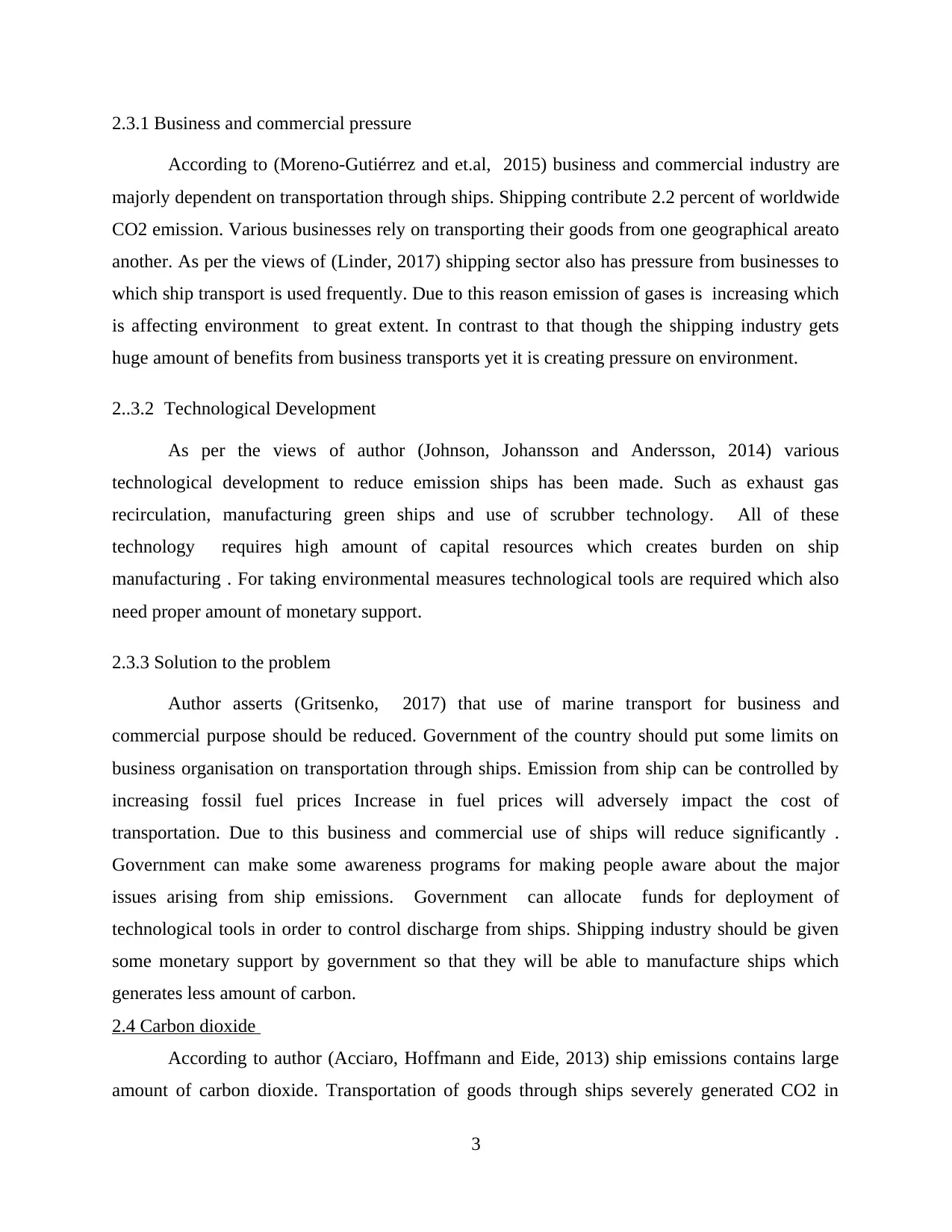
2.3.1 Business and commercial pressure
According to (Moreno-Gutiérrez and et.al, 2015) business and commercial industry are
majorly dependent on transportation through ships. Shipping contribute 2.2 percent of worldwide
CO2 emission. Various businesses rely on transporting their goods from one geographical areato
another. As per the views of (Linder, 2017) shipping sector also has pressure from businesses to
which ship transport is used frequently. Due to this reason emission of gases is increasing which
is affecting environment to great extent. In contrast to that though the shipping industry gets
huge amount of benefits from business transports yet it is creating pressure on environment.
2..3.2 Technological Development
As per the views of author (Johnson, Johansson and Andersson, 2014) various
technological development to reduce emission ships has been made. Such as exhaust gas
recirculation, manufacturing green ships and use of scrubber technology. All of these
technology requires high amount of capital resources which creates burden on ship
manufacturing . For taking environmental measures technological tools are required which also
need proper amount of monetary support.
2.3.3 Solution to the problem
Author asserts (Gritsenko, 2017) that use of marine transport for business and
commercial purpose should be reduced. Government of the country should put some limits on
business organisation on transportation through ships. Emission from ship can be controlled by
increasing fossil fuel prices Increase in fuel prices will adversely impact the cost of
transportation. Due to this business and commercial use of ships will reduce significantly .
Government can make some awareness programs for making people aware about the major
issues arising from ship emissions. Government can allocate funds for deployment of
technological tools in order to control discharge from ships. Shipping industry should be given
some monetary support by government so that they will be able to manufacture ships which
generates less amount of carbon.
2.4 Carbon dioxide
According to author (Acciaro, Hoffmann and Eide, 2013) ship emissions contains large
amount of carbon dioxide. Transportation of goods through ships severely generated CO2 in
3
According to (Moreno-Gutiérrez and et.al, 2015) business and commercial industry are
majorly dependent on transportation through ships. Shipping contribute 2.2 percent of worldwide
CO2 emission. Various businesses rely on transporting their goods from one geographical areato
another. As per the views of (Linder, 2017) shipping sector also has pressure from businesses to
which ship transport is used frequently. Due to this reason emission of gases is increasing which
is affecting environment to great extent. In contrast to that though the shipping industry gets
huge amount of benefits from business transports yet it is creating pressure on environment.
2..3.2 Technological Development
As per the views of author (Johnson, Johansson and Andersson, 2014) various
technological development to reduce emission ships has been made. Such as exhaust gas
recirculation, manufacturing green ships and use of scrubber technology. All of these
technology requires high amount of capital resources which creates burden on ship
manufacturing . For taking environmental measures technological tools are required which also
need proper amount of monetary support.
2.3.3 Solution to the problem
Author asserts (Gritsenko, 2017) that use of marine transport for business and
commercial purpose should be reduced. Government of the country should put some limits on
business organisation on transportation through ships. Emission from ship can be controlled by
increasing fossil fuel prices Increase in fuel prices will adversely impact the cost of
transportation. Due to this business and commercial use of ships will reduce significantly .
Government can make some awareness programs for making people aware about the major
issues arising from ship emissions. Government can allocate funds for deployment of
technological tools in order to control discharge from ships. Shipping industry should be given
some monetary support by government so that they will be able to manufacture ships which
generates less amount of carbon.
2.4 Carbon dioxide
According to author (Acciaro, Hoffmann and Eide, 2013) ship emissions contains large
amount of carbon dioxide. Transportation of goods through ships severely generated CO2 in
3
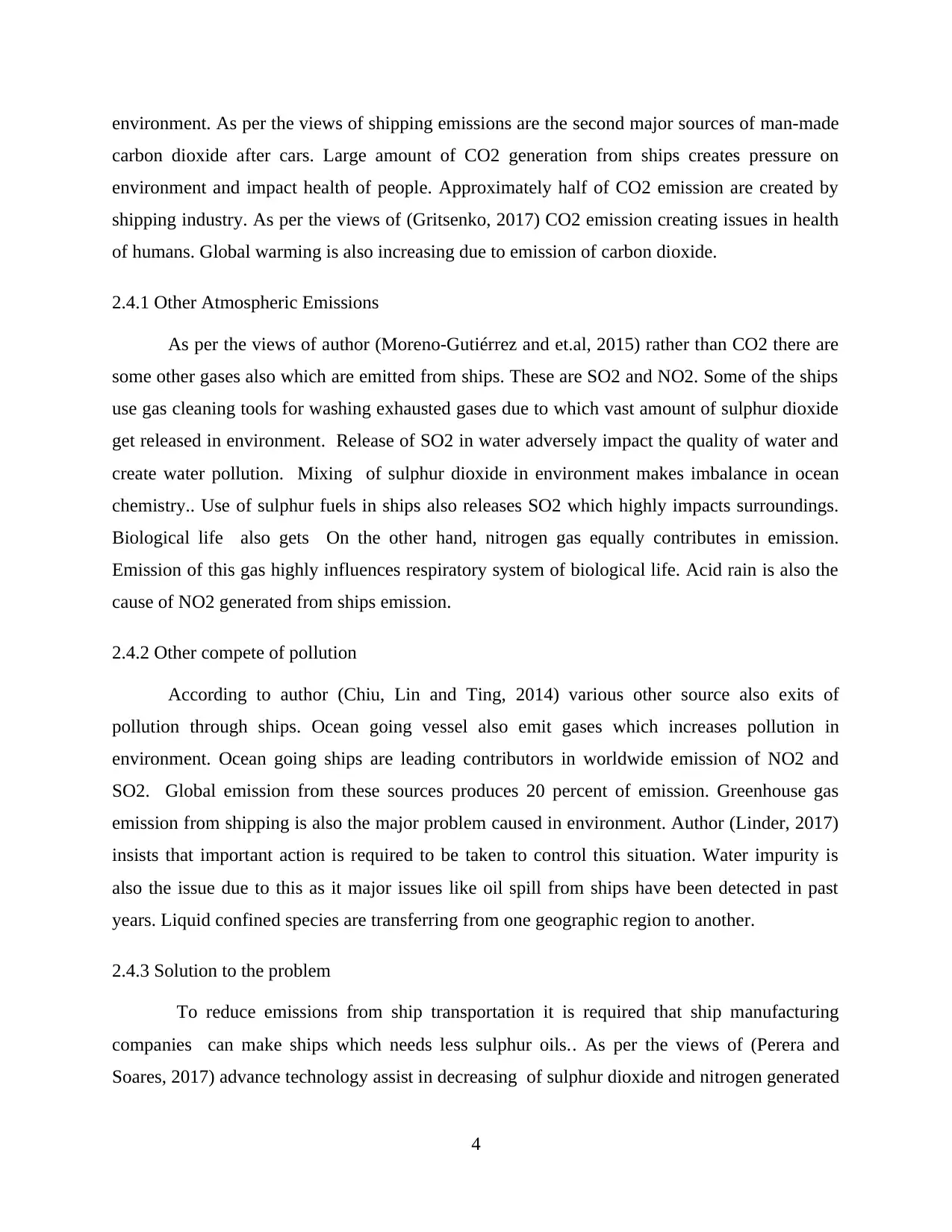
environment. As per the views of shipping emissions are the second major sources of man-made
carbon dioxide after cars. Large amount of CO2 generation from ships creates pressure on
environment and impact health of people. Approximately half of CO2 emission are created by
shipping industry. As per the views of (Gritsenko, 2017) CO2 emission creating issues in health
of humans. Global warming is also increasing due to emission of carbon dioxide.
2.4.1 Other Atmospheric Emissions
As per the views of author (Moreno-Gutiérrez and et.al, 2015) rather than CO2 there are
some other gases also which are emitted from ships. These are SO2 and NO2. Some of the ships
use gas cleaning tools for washing exhausted gases due to which vast amount of sulphur dioxide
get released in environment. Release of SO2 in water adversely impact the quality of water and
create water pollution. Mixing of sulphur dioxide in environment makes imbalance in ocean
chemistry.. Use of sulphur fuels in ships also releases SO2 which highly impacts surroundings.
Biological life also gets On the other hand, nitrogen gas equally contributes in emission.
Emission of this gas highly influences respiratory system of biological life. Acid rain is also the
cause of NO2 generated from ships emission.
2.4.2 Other compete of pollution
According to author (Chiu, Lin and Ting, 2014) various other source also exits of
pollution through ships. Ocean going vessel also emit gases which increases pollution in
environment. Ocean going ships are leading contributors in worldwide emission of NO2 and
SO2. Global emission from these sources produces 20 percent of emission. Greenhouse gas
emission from shipping is also the major problem caused in environment. Author (Linder, 2017)
insists that important action is required to be taken to control this situation. Water impurity is
also the issue due to this as it major issues like oil spill from ships have been detected in past
years. Liquid confined species are transferring from one geographic region to another.
2.4.3 Solution to the problem
To reduce emissions from ship transportation it is required that ship manufacturing
companies can make ships which needs less sulphur oils.. As per the views of (Perera and
Soares, 2017) advance technology assist in decreasing of sulphur dioxide and nitrogen generated
4
carbon dioxide after cars. Large amount of CO2 generation from ships creates pressure on
environment and impact health of people. Approximately half of CO2 emission are created by
shipping industry. As per the views of (Gritsenko, 2017) CO2 emission creating issues in health
of humans. Global warming is also increasing due to emission of carbon dioxide.
2.4.1 Other Atmospheric Emissions
As per the views of author (Moreno-Gutiérrez and et.al, 2015) rather than CO2 there are
some other gases also which are emitted from ships. These are SO2 and NO2. Some of the ships
use gas cleaning tools for washing exhausted gases due to which vast amount of sulphur dioxide
get released in environment. Release of SO2 in water adversely impact the quality of water and
create water pollution. Mixing of sulphur dioxide in environment makes imbalance in ocean
chemistry.. Use of sulphur fuels in ships also releases SO2 which highly impacts surroundings.
Biological life also gets On the other hand, nitrogen gas equally contributes in emission.
Emission of this gas highly influences respiratory system of biological life. Acid rain is also the
cause of NO2 generated from ships emission.
2.4.2 Other compete of pollution
According to author (Chiu, Lin and Ting, 2014) various other source also exits of
pollution through ships. Ocean going vessel also emit gases which increases pollution in
environment. Ocean going ships are leading contributors in worldwide emission of NO2 and
SO2. Global emission from these sources produces 20 percent of emission. Greenhouse gas
emission from shipping is also the major problem caused in environment. Author (Linder, 2017)
insists that important action is required to be taken to control this situation. Water impurity is
also the issue due to this as it major issues like oil spill from ships have been detected in past
years. Liquid confined species are transferring from one geographic region to another.
2.4.3 Solution to the problem
To reduce emissions from ship transportation it is required that ship manufacturing
companies can make ships which needs less sulphur oils.. As per the views of (Perera and
Soares, 2017) advance technology assist in decreasing of sulphur dioxide and nitrogen generated
4
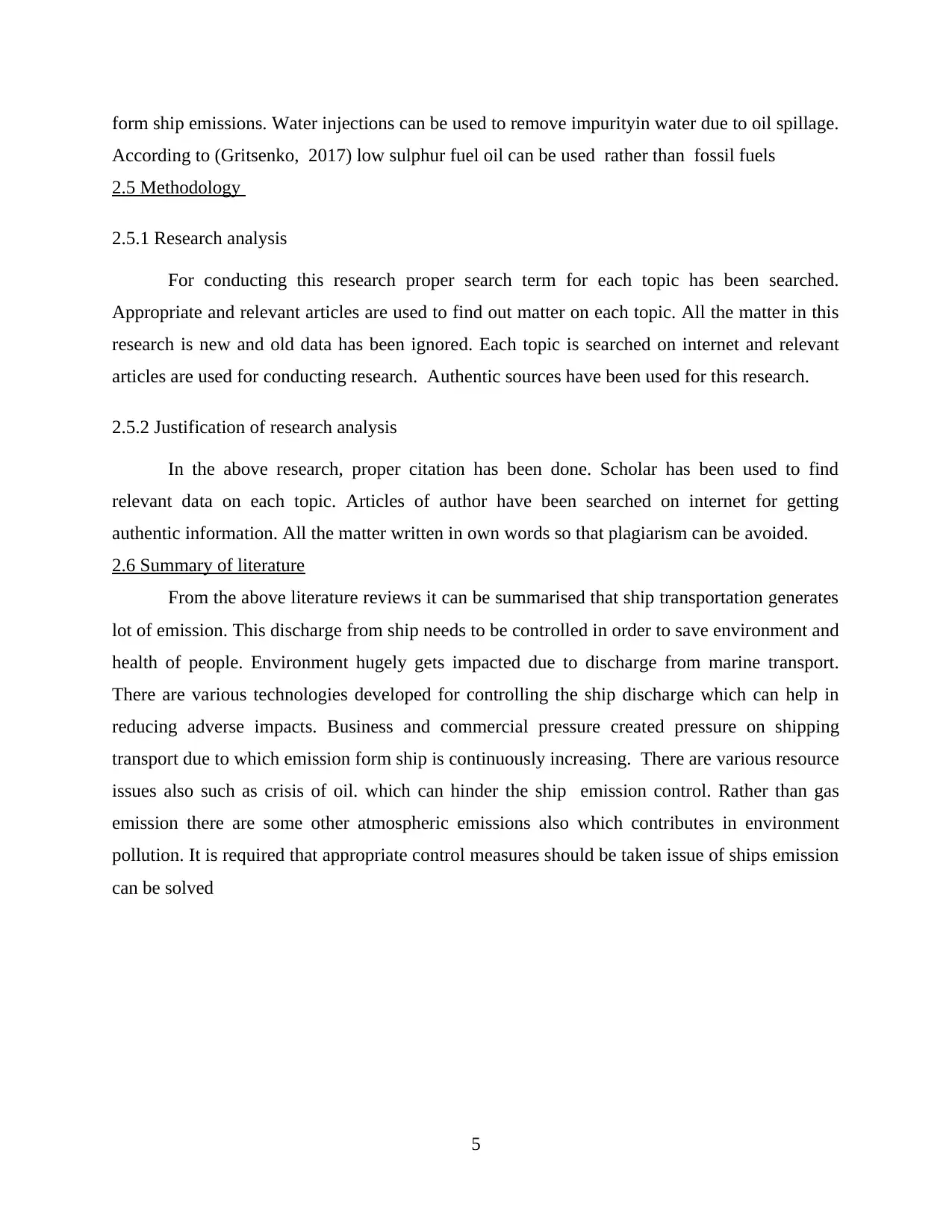
form ship emissions. Water injections can be used to remove impurityin water due to oil spillage.
According to (Gritsenko, 2017) low sulphur fuel oil can be used rather than fossil fuels
2.5 Methodology
2.5.1 Research analysis
For conducting this research proper search term for each topic has been searched.
Appropriate and relevant articles are used to find out matter on each topic. All the matter in this
research is new and old data has been ignored. Each topic is searched on internet and relevant
articles are used for conducting research. Authentic sources have been used for this research.
2.5.2 Justification of research analysis
In the above research, proper citation has been done. Scholar has been used to find
relevant data on each topic. Articles of author have been searched on internet for getting
authentic information. All the matter written in own words so that plagiarism can be avoided.
2.6 Summary of literature
From the above literature reviews it can be summarised that ship transportation generates
lot of emission. This discharge from ship needs to be controlled in order to save environment and
health of people. Environment hugely gets impacted due to discharge from marine transport.
There are various technologies developed for controlling the ship discharge which can help in
reducing adverse impacts. Business and commercial pressure created pressure on shipping
transport due to which emission form ship is continuously increasing. There are various resource
issues also such as crisis of oil. which can hinder the ship emission control. Rather than gas
emission there are some other atmospheric emissions also which contributes in environment
pollution. It is required that appropriate control measures should be taken issue of ships emission
can be solved
5
According to (Gritsenko, 2017) low sulphur fuel oil can be used rather than fossil fuels
2.5 Methodology
2.5.1 Research analysis
For conducting this research proper search term for each topic has been searched.
Appropriate and relevant articles are used to find out matter on each topic. All the matter in this
research is new and old data has been ignored. Each topic is searched on internet and relevant
articles are used for conducting research. Authentic sources have been used for this research.
2.5.2 Justification of research analysis
In the above research, proper citation has been done. Scholar has been used to find
relevant data on each topic. Articles of author have been searched on internet for getting
authentic information. All the matter written in own words so that plagiarism can be avoided.
2.6 Summary of literature
From the above literature reviews it can be summarised that ship transportation generates
lot of emission. This discharge from ship needs to be controlled in order to save environment and
health of people. Environment hugely gets impacted due to discharge from marine transport.
There are various technologies developed for controlling the ship discharge which can help in
reducing adverse impacts. Business and commercial pressure created pressure on shipping
transport due to which emission form ship is continuously increasing. There are various resource
issues also such as crisis of oil. which can hinder the ship emission control. Rather than gas
emission there are some other atmospheric emissions also which contributes in environment
pollution. It is required that appropriate control measures should be taken issue of ships emission
can be solved
5
Paraphrase This Document
Need a fresh take? Get an instant paraphrase of this document with our AI Paraphraser
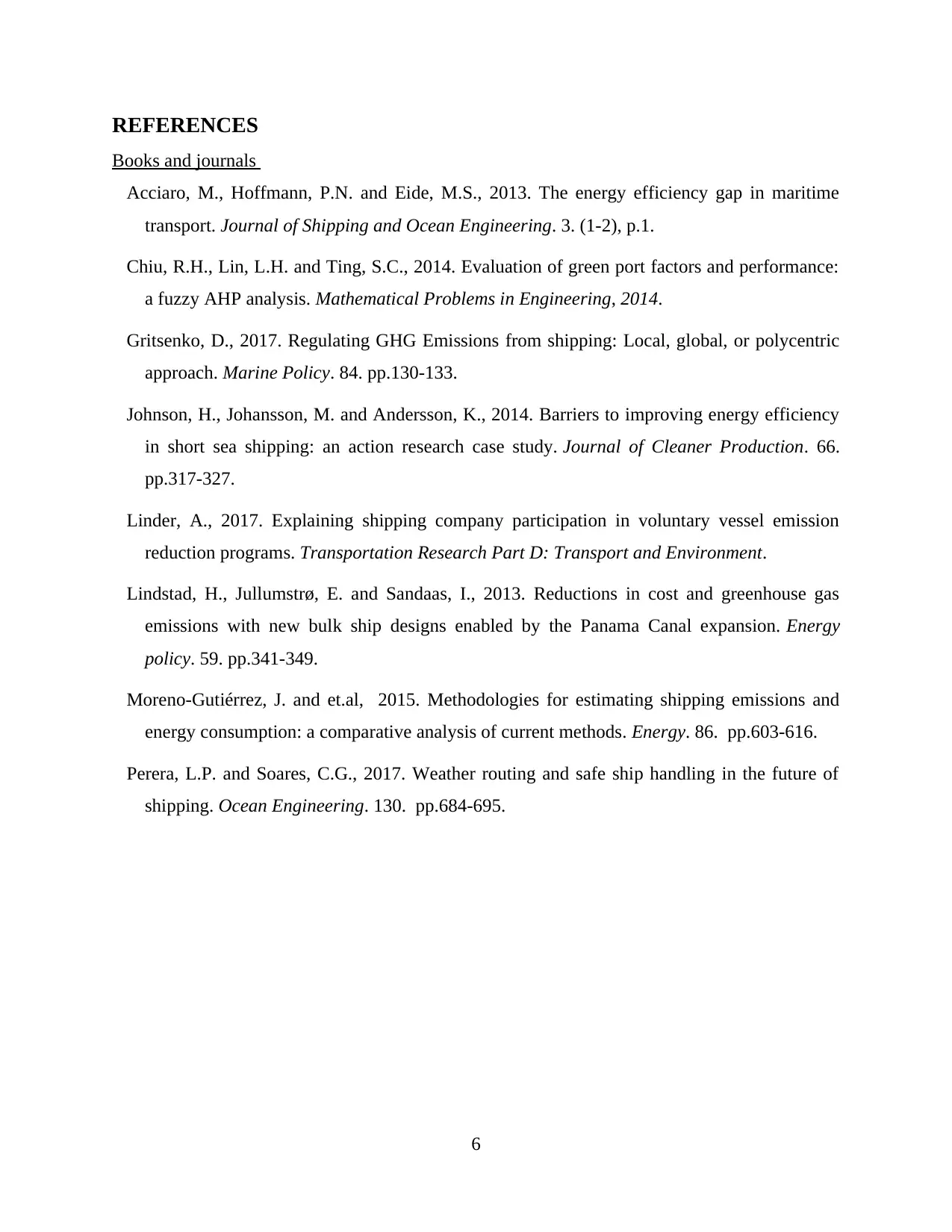
REFERENCES
Books and journals
Acciaro, M., Hoffmann, P.N. and Eide, M.S., 2013. The energy efficiency gap in maritime
transport. Journal of Shipping and Ocean Engineering. 3. (1-2), p.1.
Chiu, R.H., Lin, L.H. and Ting, S.C., 2014. Evaluation of green port factors and performance:
a fuzzy AHP analysis. Mathematical Problems in Engineering, 2014.
Gritsenko, D., 2017. Regulating GHG Emissions from shipping: Local, global, or polycentric
approach. Marine Policy. 84. pp.130-133.
Johnson, H., Johansson, M. and Andersson, K., 2014. Barriers to improving energy efficiency
in short sea shipping: an action research case study. Journal of Cleaner Production. 66.
pp.317-327.
Linder, A., 2017. Explaining shipping company participation in voluntary vessel emission
reduction programs. Transportation Research Part D: Transport and Environment.
Lindstad, H., Jullumstrø, E. and Sandaas, I., 2013. Reductions in cost and greenhouse gas
emissions with new bulk ship designs enabled by the Panama Canal expansion. Energy
policy. 59. pp.341-349.
Moreno-Gutiérrez, J. and et.al, 2015. Methodologies for estimating shipping emissions and
energy consumption: a comparative analysis of current methods. Energy. 86. pp.603-616.
Perera, L.P. and Soares, C.G., 2017. Weather routing and safe ship handling in the future of
shipping. Ocean Engineering. 130. pp.684-695.
6
Books and journals
Acciaro, M., Hoffmann, P.N. and Eide, M.S., 2013. The energy efficiency gap in maritime
transport. Journal of Shipping and Ocean Engineering. 3. (1-2), p.1.
Chiu, R.H., Lin, L.H. and Ting, S.C., 2014. Evaluation of green port factors and performance:
a fuzzy AHP analysis. Mathematical Problems in Engineering, 2014.
Gritsenko, D., 2017. Regulating GHG Emissions from shipping: Local, global, or polycentric
approach. Marine Policy. 84. pp.130-133.
Johnson, H., Johansson, M. and Andersson, K., 2014. Barriers to improving energy efficiency
in short sea shipping: an action research case study. Journal of Cleaner Production. 66.
pp.317-327.
Linder, A., 2017. Explaining shipping company participation in voluntary vessel emission
reduction programs. Transportation Research Part D: Transport and Environment.
Lindstad, H., Jullumstrø, E. and Sandaas, I., 2013. Reductions in cost and greenhouse gas
emissions with new bulk ship designs enabled by the Panama Canal expansion. Energy
policy. 59. pp.341-349.
Moreno-Gutiérrez, J. and et.al, 2015. Methodologies for estimating shipping emissions and
energy consumption: a comparative analysis of current methods. Energy. 86. pp.603-616.
Perera, L.P. and Soares, C.G., 2017. Weather routing and safe ship handling in the future of
shipping. Ocean Engineering. 130. pp.684-695.
6
1 out of 8
Related Documents
Your All-in-One AI-Powered Toolkit for Academic Success.
+13062052269
info@desklib.com
Available 24*7 on WhatsApp / Email
![[object Object]](/_next/static/media/star-bottom.7253800d.svg)
Unlock your academic potential
© 2024 | Zucol Services PVT LTD | All rights reserved.





